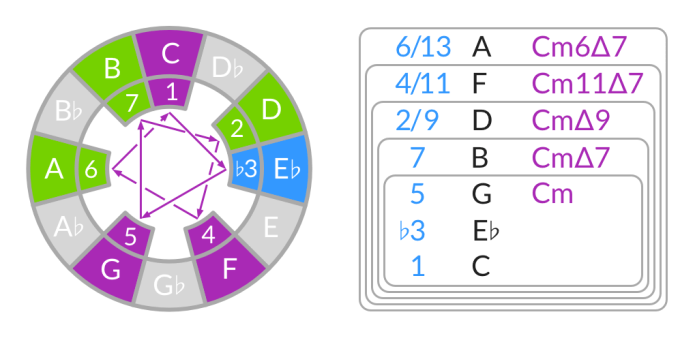+ Combine theory, improvisation, and jazzy hip-hop, and improve your piano chops with Grammy-winner Kiefer in Kiefer: Keys, Chords, & Beats.
Jazz musicians think of chords and scales as two different ways of looking at the same thing: a group of pitches that sound good together. If you organize the pitches sequentially and play them one at a time, you get a scale.
If you stack them up and play them simultaneously, you get chords.
To make a chord, you start on the first note of a scale and then move up it in thirds, meaning that you skip every alternating note. To get more notes for your chord, just keep adding thirds on top. Watch how this works below.

Here’s how this works (basically):
- If you start on the first scale degree, add the third scale degree, and then add the fifth scale degree, you get a simple three-note chord called a triad.
- If you add the seventh scale degree on top, you get a seventh chord.
- Next you come to the ninth note of the scale, which is really just the second note an octave up. Adding it gives you a ninth chord.
- Then you come to the eleventh note of the scale, which is the fourth note an octave up. Adding it gives you an eleventh chord.
- Finally, you arrive at the thirteenth note of the scale, which is the sixth note an octave up. Adding it gives you a thirteenth chord.
- The next third after the thirteenth is just the root of the scale. You’ve now used every possible note in your chord.
A brief aside…
We recently launched a video on our YouTube channel that teaches any musician how to memorize every common note interval using only movie themes from John Williams scores. It’s…pretty rad. Musicians, composers, and curiosity-junkies, check it out and subscribe if you like that sorta thing!
Major Chords
Major scales have four semitones (piano keys) between their first and third degrees. This interval is called a major third, and it appears in all major chords. In C, there’s a major third between C and E.
Major Scale Chords
The major scale is the plain vanilla of the European-descended harmonic universe. The chords aren’t all smooth and consonant, though; the fourth clashes with the third, so if you’re going to make a major eleventh chord, typically you’d leave the third out. Of course, if you want some dissonance, by all means, use both.
Mixolydian Mode Chords

The chord combining a major third with a flat seventh is called a dominant seventh chord.
The interval between the dominant seventh chord’s third and seventh is called a tritone. The sound of the tritone resolving to a “nicer” interval is the structural basis of all Western tonal harmony. In more modern music, tritones need not resolve at all. In blues, rock, and jazz, dominant seventh chords can act as home base.
Lydian Mode Chords

Unlike the major scale, Lydian has no clash between its third and fourth scale degrees. They sound terrific together, giving a smooth and creamy sound. Any time you have a major chord that isn’t the tonic, try putting sharp eleventh in it.
Lydian Dominant Mode Chords

The Lydian dominant mode has two tritones in it, so the chords it produces are exotic and modern-sounding.
Phrygian Dominant Mode Chords

Phrygian dominant is the minor-key equivalent of Mixolydian. The dominant seventh flat ninth chord defines minor keys. Like Mixolydian, Phrygian dominant can also stand on its own, creating a strongly Middle Eastern or Jewish feel.
If you ignore the root, the rest of the notes form an E diminished chord. Notice also that the top three extensions form a D-flat major triad. The top four form a B-flat minor seventh chord. D-flat major and B-flat minor are both subdominant chords in the key of F minor. These are nice chords to use over a C root to create a suspended feeling in your minor key dominant chord.
+ Enjoy access to Soundfly’s suite of artist-led music learning content for only $12/month or $96/year with our new lower price membership. Join today!

Minor Chords
Minor scales have three semitones (piano keys) between their first and third degrees. This interval is called a minor third, and it appears in all minor chords. In C, there is a minor third between C and E-flat.
Natural Minor Scale Chords

Usually you don’t extend natural minor chords past the eleventh, so the chord symbol for the thirteenth chord is not a standard one. The seventh, ninth and eleventh of a C natural minor chord form a B-flat major triad.
Dorian Mode Chords

The uppermost three extensions to the C Dorian chord form a D minor triad. Combining D minor and C minor chords gives a distinctive Dorian sound nicknamed the “So What” riff.
Harmonic Minor Scale Chords

The seventh chord you get from harmonic minor is called the minor-major seventh chord, and as the name suggests, it has an ambivalent feeling. Arpeggiating this chord gives a distinctive uneasy feeling that would sound great in an Alfred Hitchcock movie.
Melodic Minor Scale Chords

Melodic minor gives the same major-minor seventh chord as harmonic minor. The scale contains two tritones, and its chords are richly dark and strange.
Phrygian Mode Chords

The upper extensions in the C Phrygian chord form a D-flat major triad, and just playing the triad over C makes a classically Phrygian sound.
Locrian Mode Chords

The seventh chord from Locrian is an important one: minor seventh flat five, also known as the half-diminished chord. It’s the minor-key subdominant chord, and it’s ubiquitous in jazz. If you ignore the root, the rest of the notes form an E-flat9 chord.
More Chord Facts
It’s not necessary to use every note in a chord. If you want to create a chord with upper extensions, it usually sounds better to leave out some of the lower notes. You can often leave the fifth out of a seventh chord, and leave both the fifth and the seventh out of a ninth chord. Also, it is not necessary to stack the notes up in order. The specific order and arrangement of the notes in a chord is called a voicing, and good voicings are essential to effective chord use.
To get exceptionally hip chord voicings, try building them out of fourths instead of thirds. Instead of stacking up every other note in the scale, take every third note. Here’s how you’d build chords in fourths from the Dorian mode:

Fourths chords have an airy, open feeling, and if you leave out the root, you get a nice shimmering ambiguity. 1960s jazz pianists like McCoy Tyner use a lot of fourths chords. You can get an even hipper sound by combining fourths and seconds (adjacent scale tones.)
This list doesn’t begin to encompass all the chords you’ll find out there, but at least it’s enough to get started. Trust your ears and enjoy.
Play Your Heart Out!
Continue your learning adventure on Soundfly with modern, creative courses on songwriting, mixing, production, composing, synths, beats, and more by artists like Kiefer, Kimbra, Com Truise, Jlin, Ryan Lott, RJD2, and our newly launched Elijah Fox: Impressionist Piano & Production.





